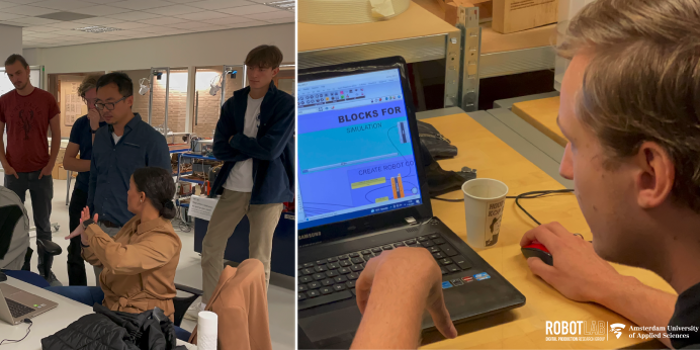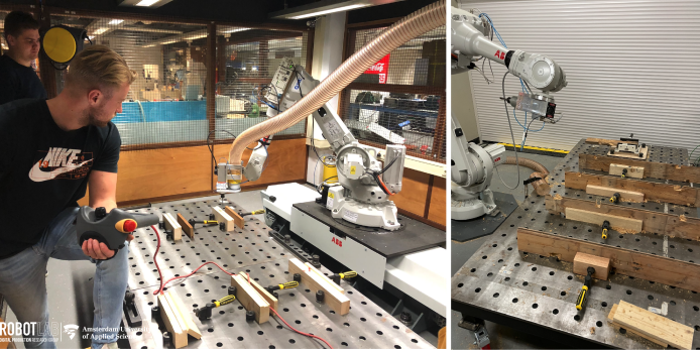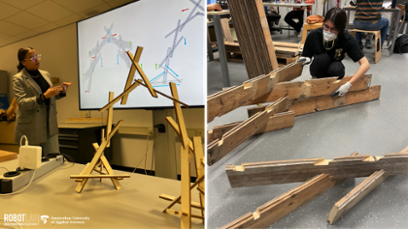Minor Robotic Production and Circular Materials (RP&CM)
Creative students, enthusiastic entrepreneurs
14 Feb 2022 14:00 | Faculty of TechnologyFrom clothes hangers that can be converted into a retail chandelier to a tailor-made room divider made from seaweed – there was one creative design after another in the final presentations of the students for the last module of Circular Production Applications for the minor RP&CM, which took place on 21 January 2022. The course was guided by teacher-researchers from the Faculty of Technology and hosted at the Digital Production Research Group | Robot Lab.
Stimulate creativity, realise innovations and create impactful applications is the objective of Circular Production Applications, the last module in the minor Robotic Production and Circular Materials.
Practical cases
In this last module, students were asked to come up with an innovative circular solution for a certain circular or waste material, a challenge linked to issues facing real companies. “They researched how they could improve or even change the properties of the material; for example, for a better service to customers, a more efficient production process or to arrive at a completely new product. And they use computational design and robotic production to create designs and test solutions,” explains Marco Galli, lecturer-researcher at the Robot Lab of the Amsterdam University of Applied Sciences (AUAS) and coordinator of the course. Together with six other teachers, he also mentored the students.
Different fields of study The module, designed for third-year students who had already participated in the Making the Green Mile Makeathon last fall, lasted a total of eight weeks. About 24 national and international students, all from different backgrounds and schools, took part.
The outcomes are exciting. For example, a group of students for Hooks Creative – a manufacturer of clothes hangers – came up with a concept that allows retail stores to transform surplus hangers in their stores into elegant chandeliers or interior elements, instead of sending them back to be burned. They examined how the company could turn this into an interesting circular business model and looked at the issues of fast fashion in general.
SeaWall
Another group of students , together with the company Blue Blocks, investigated applications for a new circular material made from seaweed. The material was found to have good acoustic properties. “They have turned it into a partition wall for interior spaces such as an office. The wall consists of panels that can be recycled and reused,” Galli elaborates. The students also came up with a design for a website and an augmented-reality app with which users can indicate exactly what the wall should look like. “This will enable the company to provide tailor-made solutions,” says the lecturer-researcher.
Other cases concerned the efficient production of circular materials with waste from sewage treatment (Omlab), the introduction of a robotic production line in a carpentry factory (Timmerfabriek Visser) and solutions for the reuse of rubber floors in playgrounds (Carve).
Broad vision
The students responded enthusiastically. “This course has given me insight into how robotic production and circularity can change the world. And I learned to think and design in a different way,” said one of them. Others mentioned they appreciated the teamwork and interaction with students from different backgrounds.
“The students also found it very inspiring to work with entrepreneurs,” Galli says. “And thanks to this module, they have developed a broader vision of circularity and new means of design to production. For example, they learned what the difference is between a linear and a circular business case, namely focusing on the big picture and that you have to include new ways of thinking circular along the different processes. And they now know that circular materials don't necessarily have to come from waste; you can also make them from a raw material like seaweed.”
According to Galli, the course underlines the added value of involving students in research. “They are the professionals of tomorrow. With their fresh perspective, they come up with solutions that today's generation would not think of.”

ir. M.R. GalliMSc.
Go to detailpage


